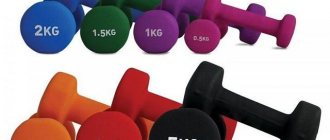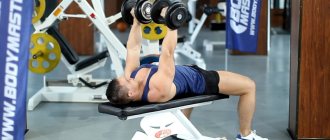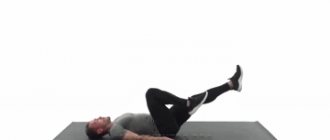For those who are in the hall for the first time
If this is your first time coming to the gym, you need to take into account your preparation. Often there is none at all. How to determine the working weight in this case? So far, no way.
People go to swing because they “already have the urge.” Therefore, the first training session is a very important moment. If you get a bad impression from (or after) her, you won’t come here a second time.
Usually the number of approaches and weight are selected by the trainer. Wait! Does the trainer have the necessary education and courses? Or is he just a home-grown muscleman who has achieved rapid progression through bad means? They are the ones to be afraid of.
The first training session should be an introductory one. We recommend not selecting weights yet, but taking what is not heavy for you at the moment. That is, if it’s a barbell, then it’s one that you can easily lift. After all, you will be lifting the barbell repeatedly, so even the weight that seems too light to you for one concept will put a noticeable load on the muscles. This is important not only for beginners, but also for guys weakened by a long break.
So, why is it important to work with minimal weights in the first workout:
- Your muscles don't know what hardware is.
- You don't have enough stamina yet.
- You don't know the technique of doing the exercises.
Simply put, you will easily get a sprain, or your muscles will be sore for a week after training. Believe me, after this the second time you are unlikely to want to come to the gym.
Correct selection of weights at the first visit - an empty bar for bench presses, dumbbells 2-5 kg for other exercises. If you want to squat, use an empty bar. Learn technique! And if the trainer tells you that the weight is light and you need to add more, don’t listen to him. This is the first training session.
There have been many cases when, after such training, a person has a fever for a week, and he cannot bend or straighten his arms. Why do you need this?
The first workout is a minimum of weights. The same goes for the number of approaches. We recommend doing 2 approaches. But you can get the program from the trainer. Or have a trainer show you what to do that day.
Example for beginners
The trainer told you to do 3 sets of all exercises. Reps: 10-15. Your task is to do 2 sets with the same number of repetitions. For bench press/squat/deadlift, it is better to take an empty bar or add 10 kg. Arm flexion-extension, dumbbell press – 5-6 kg. And isolated shoulder exercises are best done with 3-4 kg. You will understand why.
If everything comes very easily, most likely you are doing it wrong. In the case of dumbbell lateral raises, for example, if it’s easy for you, then most likely you bend your arms too much, or you haven’t turned your elbows up. Incorrect technique is easier to do. Remember!
Without fatigue there is no development
The famous fitness scientist Brad Schoenfeld has repeatedly made similar conclusions in his studies - hypertrophy is similar, and strength grows better from heavy weights than from high repetitions [18, 19, 20].
A completely logical question may arise - why do we walk every day, supposedly, a lot of repetitions, but our legs don’t grow? We bring our hand with a spoon to our mouth a lot and often, but our biceps don’t grow? Another outstanding professor Vladimir Mikhailovich Zatsiorsky, who wrote a lot of educational literature in the field of muscle biomechanics, whose works are fundamental in higher educational institutions in the field of physical education, said something like the following: “A muscle fiber that is involved in work, but is not tired, does not develop .”
And here we are talking about those very “stimulating repetitions” [21]. That is, even if we “move the cabinet” once, our muscles will not grow either, although it seems to be heavy.
When lifting more weight, the first few repetitions will be “idle”; there is no particular benefit from them, because metabolic stress has not set in, the body has not yet realized that it cannot cope, and there is no need for it to attract “additional forces” and stimulate the growth of new muscles. By lifting less weight, we have even more “idle” repetitions, and only towards the end will the body begin to “stress.”
Thus, working to “failure” in itself is not a prerequisite for hypertrophy, but the key repetitions are those that are as close to failure as possible !
After a long break
After a forced break in training, we recommend doing 2 sets instead of 3 or 4. And taking the weights 50% of those you used when you were still training. Yes, after training your muscles will ache. Strongly. But not so much that you fall behind schedule for a week.
In the future, you will gradually return to your working weights and begin to progress. Start small and increase the weight in each approach: for a barbell - by 10 kg, for dumbbells - by 2. You definitely won’t miss!
Bench press example
Warm up: empty bar, 20 reps. We weigh 10 kg and do a set. We hang another 10 and work. And so we reach 60 kg. If it becomes difficult in some approach, then there is no need to increase the weight in this workout. In the future, when it becomes difficult, add 1-2 kg and look at the result.
Where to start for beginners
For beginners entering the gym for the first time, everything is simple - take the minimum weight of the weight and study the technique of performing the exercises . “Minimum” is one or two 5 kg bars in a block, 1-2 kg pink dumbbells or a 12, 15 or 20 kg barbell, or you can start with a six-kilogram bodybar and you don’t have to be shy. In the end, both your health and further progress in training depend on how well you perform the exercise technique.
On the other hand, the question arises - what prevents you from using equipment with a slightly larger weight, if it is very easy for a person to lift a barbell? Nothing stands in the way - go ahead and sing! Moreover, some idiot coaches practice such a method as “load the beginner harder to understand his strength capabilities.” At the same time, an inexperienced friend will think that the training went well if he cannot straighten up in the morning after the gym and cannot get up from the toilet without outside help. It just doesn't end well in the end.
The fact is that with a relatively large weight of weight, it is almost impossible to learn how to do the movement correctly . You're just trying to somehow squeeze the weight, just to beat it - bending and squirming under the bar like crazy.
At the same time, with a minimum weight it is quite easy to work in the correct amplitude and, most importantly, remember the movement! Yes, yes - just remember. The more you repeat the movement, the better you will remember and eventually you will perform it correctly automatically, without thinking and regardless of the weight of the burden, even if you have your maximum maximum in your hands.
When you just start learning this or that exercise, your head is loaded no less than your muscles. Let’s say that in a bench press you think about keeping your shoulder blades together, the bar lying on the base of your palms, smoothly lowering to the middle of your chest with a touch, and not fully extending your arms when lifting (do not insert your elbows). At the same time, the barbell “storms and chatters” from side to side, because the stabilizer muscles are not yet accustomed to such work, and it is difficult for the brain to send a synchronous impulse to both hands - a new activity for it.
Another example is squats with a barbell on your shoulders : you keep your lower back arched, tense your abs (keep your stomach pulled in), carefully squat, moving your pelvis back if necessary and leaning forward a little so that your knees do not go beyond the line of your toes, then you smoothly stand up, but at the end You don’t fully extend your leg movements (you don’t put your knees in), then you repeat the movement again. Again, it is difficult to perform the exercise correctly the first time, and you also need to choose a comfortable position for the legs, decide on the movement itself, taking into account the length of the thighs and lower legs, etc. Naturally, if you load the barbell right away, it is impossible to do all this.
Working with minimal weight and the correct range of motion, the more times you repeat the movement, the better you will perform it . The cerebellum is responsible for this - it remembers which motor units and in what sequence need to be used under certain conditions, and as a result, the movement will be performed automatically without additional control on your part. In addition, in the process, the brain looks for ways to perform the movement most effectively, taking into account your own structure. After all, we are all different, different levers, muscle attachments, etc. If you try to learn a technique with heavy weights, then there is a high chance of “training” the cerebellum for incorrect movement, which ultimately can lead to injury.
By the way, the “Blind typing method” is studied in exactly the same way - the cerebellum “remembers” its movement for each finger and, as a result, there is no need to control the hands. All your thoughts are instantly transferred into text without having to look at the keyboard and think about the typing process. Actually, this is how I type this text.
Remember the practices of martial arts, when in order to study a particular technique and strike it is necessary to repeat the movement hundreds, or even thousands of times, to develop complete automatism. This all works for gym exercises too.
Weight selection during training
Now you know where to start training for the first time or after a long break. What to do next? And then we will learn to listen to our body and predict the desired weight.
The principle of any progress is to work at your maximum, “to failure.” The state of “failure” is a special feeling when you can no longer do a single repetition. Failure may occur earlier than planned if you choose too much weight. And later, if you made a smaller mistake.
For muscle growth, failure should occur within 6-12 repetitions. If less, you work on strength, if more, on endurance. Therefore, the weight is selected so that you can do at least 6 repetitions with it, but cannot do more than 12. How to guess this weight? By trial and error.
The first approach to any exercise is a warm-up. For example, before a bench press, you take an empty bar and do 15-20 repetitions with it. At this moment you can already feel how easy it is for you. You can compare this feeling with your last workout and roughly calculate the weight for this one.
When you start with light weights and gradually increase them, at some point you will get that precious number of pounds that you will work with until failure. We need to come to this.
This weight will increase from workout to workout. Slowly, but it will happen, believe me. Thus, when the required number of repetitions (6-12) and this weight comes easy to you, it’s a good sign to add 1-2 kg to the barbell. Or increase the number of repetitions if you do them less than 12. And then increase the working weight anyway, returning to the previous number of repetitions.
Finding the right weight right away, especially during the first workouts, is an impossible mission. That's why we start small. And the body itself decides what is enough for it and what is just right.
Determining the initial load for a beginner
First of all, it should be noted that the weight of the apparatus in the exercise depends on the number of repetitions. The goal of the training (strength, mass or weight loss) is also of great importance. As a rule, beginners strive to increase muscle volume. In this case, the recommended number of repetitions in each approach will be in the range from 8 to 12. It is the “8-12” interval that provides the optimal time under load, which promotes hypertrophy of muscle fibers.
Methodology
So we know the quantitative rep range. Now you need to determine the starting weight. Let's say right away that the load should be such that the last 2 repetitions are performed with maximum effort. That is, each approach must be completed with muscle failure.
For example, let's take one of the most popular exercises - the bench press. If you have never done strength sports, start with an empty bar (20 kg). Do 20 chest presses. This will help stretch the muscles and joints of the arms, and will also allow you to assess your physical fitness.
If 20 reps with an empty bar are easy, feel free to add 10 kg on each side. In total you will get a barbell weighing 40 kg. Perform 12 lifts. If failure occurred in the “8-12” range, it means that in this exercise you were able to find the optimal starting weight.
If you couldn’t do even 7-8 chest presses, then you need to reduce the load. Reduce the total weight of the bar by 5 kg (remove 2.5 kg on each side) and repeat the set. In this way, you can choose the optimal weight load just for you.
If, after 12 lifts of a 40 kg barbell, you feel that you can do a few more repetitions, then you should increase the weight of the apparatus. We recommend using 5kg increments (2.5kg on each side) until you find the optimal load.
This method of “feeling” the weight should be used only in the first lesson. The next workout should begin not with an empty bar, but with the selected optimal value (of course, do not forget about the warm-up exercises).
The technique is suitable not only for bodybuilders, but also for athletes who want to develop exclusively strength characteristics. In this case, no more than 6 repetitions must be performed in each approach. And it’s best to start picking up weight not from 40, but from 55-60 kg.
Progression of loads
The growth of muscle mass occurs only with a regular increase in working weights. In this case, the basic rule - the onset of failure in the interval of “8-12” repetitions - must remain unchanged. That is, when the load increases, you cannot go beyond these limits.
So, let's take the already familiar example of the bench press. Let's say you have determined the working weight - 40 kg. That is, at the first training session, this exercise should be performed like this:
Warm-up: empty bar – 20 reps.
- 40 kg for 12;
- 40 kg at 11;
- 40 kg for 10;
- 40 kg for 10.
A gradual decrease in the number of repetitions is normal. It is associated with the consumption of glycogen (energy reserves in the muscles and liver). At the next workout for the pectoral muscles (in a week), you need to increase the weight of the barbell by 2.5 kg. That is, the execution scheme will look like this:
Warm-up: empty bar – 20 reps.
- 42.5 kg at 11;
- 42.5 kg per 10;
- 42.5 kg at 9;
- 42.5 kg for 8.
Please note that due to the increase in load, the number of repetitions in the approaches fell, but did not go beyond the “8-12” interval.
An important point is that you cannot increase the weight of the barbell every workout. Otherwise, this will most likely lead to the fact that in one of the approaches you will “jump” beyond the lower limit of the recommended interval, that is, you will not do even 8 repetitions. Increasing the weight of the apparatus should only occur when in the first 2 working sets you can do 12 full repetitions. Take your time, it may take 2-3 weeks. The optimal step for increasing weight values is 2-4 kg.
Dependence of weights on training goals
When selecting weight, you can focus on the following criteria:
- If your goal is muscle and mass growth, failure should occur at 6-12 repetitions, as mentioned earlier. If you hit, say, on the eighth repetition, try doing the next workout 9. Then 10, 11, 12. After you complete 12 sets, add weight to the barbell.
- If your goal is to increase strength, the weights taken are more significant. Failure should occur before 6 repetitions. And you need to do few repetitions in the approaches.
- If you're doing endurance work, the weight used is reduced so you can do more reps. Failure should occur not at the 12th repetition, but at the 30th. In general, it’s better to go jogging. In your case, it is important to choose the type of sport, not the number of kg.
- Recovering from sprains requires light weights. You need to exercise for a very long time (months) with light weights, strengthening the healed ligaments. Haste is dangerous and inadvisable.
The relationship between weight and number of repetitions
If you clearly define your goal , calculating the right weight for training will not be difficult. Remember, the heavier the weight, the fewer repetitions you should perform . With less weight you need to perform more repetitions.
For example, if your maximum bench press weight is 102 kg, then the number of reps you can perform with progressively increasing weights might look something like this:
| Weight, kg) | 65 | 70 | 75 | 79 | 84 | 88 | 93 | 98 | 102 |
| Repetitions | 12 | 11 | 10 | 9 | 7 | 5-6 | 4 | 2 | 1 |
It is also important to create an individual training plan . If your goal is to increase strength, then you should perform the bench press with a weight of more than 88 kg, for increasing muscle size , train with a weight of about 65-84 kg, and for muscle endurance , choose a lighter weight, in the table it is 55 kg.
Everyone has their own limit for a specific exercise. You can learn your strength through regular practice and technically correct repetitions. You should definitely make sure that you are using the weight that best suits your goals . If you're used to starting an exercise with a warm-up set, you can always rack the bar long before muscle failure and treat this as another warm-up set if you think you're not getting into the desired rep range. For the next set, choose a more appropriate working weight . Also try recording your results in a notepad or smartphone, which will save you from guessing the working weight at your next workout.
What to do for girls
It doesn't matter what gender you are. The mechanism of muscle progress is the same for everyone. The weights will just be different. A man squats with a weight of 100 kg, and a woman - 30-50, for example. The feeling is the same, the refusal is the same. The principles are the same, so feel free to use the above recommendations.
A separate article on our website is devoted to choosing the weight of dumbbells for women.
Weight selection for weight loss
It is believed that the best type of training for burning subcutaneous fat is intense cardio.
Running, cycling, Nordic walking, active gaming disciplines, plyometrics - all this, when used regularly, helps to get rid of extra pounds. As a rule, the effectiveness of such types of fitness depends on the time spent under load. Experts recommend doing aerobic training for at least 50-60 minutes 4-5 times a week. Recent studies by Western scientists have shown that when combining strength training with aerobic exercise, the rate of fat burning increases. This means that the most effective weight loss regimen combines gym fitness and cardio training. In this case, determining the weight of the shells is a strictly individual factor. It is necessary to choose a load that will allow you to do 15-20 full repetitions in each approach.
The basis of a fat burning program should be strength elements: deadlift, squat, chest press. These exercises should be distributed over 3 workouts per week. The initial weight of the weights should be small (for example, an empty 20 kg bar). Girls are allowed to do Romanian deadlifts with dumbbells instead of deadlifts. Additional exercises are performed at a fast pace. On rest days, you should do 60-minute cardio sessions (2-3 times a week).
What to do during a plateau
When you don’t feel a surge of strength for a long time, and your results barely stay at the same level, this means one thing - you have reached a plateau in your capabilities. Strength is not growing, there is no progress. And a bad mood and weak self-confidence often lead to a “kickback” of the security forces.
Now we need to be patient and work hard in the gym. Let the weights be the same. Try to increase them by 0.5 kg, at a minimum. Reconsider your lifestyle. Maybe it's not the training at all?
There is an opinion that to overcome a plateau during training you need to lose weight. As a rule, this option is good for those who take pharmacology, that is, for professional bodybuilders. So just be patient and maintain the level you have achieved. In 90% of cases, progress will come.
What should former athletes do?
If you once worked out in the gym, achieved certain results, but then abandoned the whole thing for six months or more, then you start with the same thing that beginners start with. From empty bars and pink dumbbells. Before doing hardcore, you need to restore muscle tone, neuromuscular connection, remember the movements, or even learn them again under the guidance of an experienced trainer.
It’s the same with increasing the weight of the weights - a little at a time. Although a former athlete will progress faster than a beginner. There is a muscle memory effect and usually a person regains his peak form of the past in 3-4 months with a reasonable approach, after which he can reach new records.
Practical advice
- Keep a training diary. It should include the date of the lesson, the name of the exercise, the number of approaches and repetitions done, and the weights. You can choose the right working weight based on your own records. Your diary is the best adviser on what weight to start training with after a break, or where to start the next workout.
- Don't increase your weight suddenly. Many beginners do this: in the first workout they pressed an empty bar (20 kg), in the second it was 50 kg. This is stress for the muscles. Not every person will survive this easily. It is optimal to take steps of 10 kg. And if you have already exercised, you can raise the working weight by 40 kg in 4 approaches. At the same time, you will find out what your muscles are now capable of.
- When you immediately take the weight you think you need, you may make a mistake. That is, choose a heavy barbell weight. This will cause you to get tired before your work sets are completed. There is no need for any persistence here - remove a couple of weights from the barbell.
- Working “to failure” in the first workout is very dangerous. Just like the second one. The body should get used to the stress within a month. During this period, your task is not to chase the scales, but to practice your technique. If you can do more, that's good (that's what happens most often). Work on your movements, strengthen your ligaments.
How to add working weights to the barbell
The specific weight on the bar depends on how many sets and reps you intend to do. For beginners, as a rule, the following options are used:
- 5 sets of 5 reps.
- 3 sets of 8 reps.
- 3 sets of 10 reps.
Choose any - they will help build muscle and strength equally well.
Follow the following pattern:
- Perform the first approach with the bar. Do it with concentration and with full force, even if it is very easy for you. This will help you warm up and prepare your muscles and nervous system for training with heavier weights.
- Add 1.25 kg or 2.5 kg pancake per side. The weight will depend on how easy it is for you. Follow this approach. If your technique is still perfect and you find it easy even in the last reps, add another 5–10 kg. Be guided by sensations - the easier the exercise is perceived, the more weight you can add to the barbell.
- Continue adding weight in this manner until the shape begins to break. As soon as this happens on any of the repetitions, roll back to the previous number of kilograms - this is your working weight.
For example, you did squats with a 50 kg barbell on your back. All five repetitions were with good technique, although the last one was difficult. You weigh another 5 kg, and on the fifth rep you can’t keep your back straight, and your knees turn inward. This means your working weight in this exercise is 50 kg. Keep working with him.
Research the question











